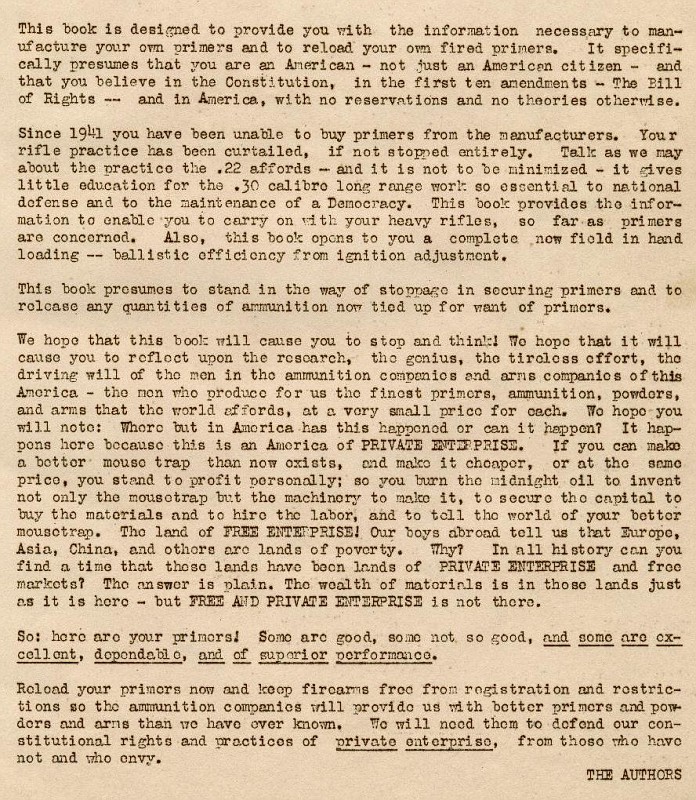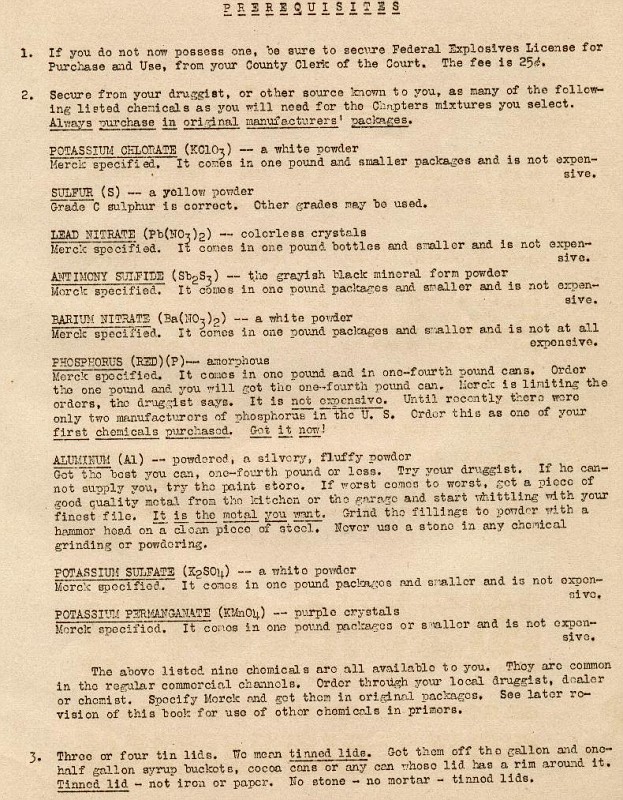You guys are great..honest, I'm thinkin I might make cookies, never blew up a cookie before............
Well I hope the job market turns around soon, I'm tired of sitting around
Thanks for all the good input..you guys are awsome............
Mike Hoffman

Bunch of experts here, huh?
I was offering this digitized version of this on another forum on a CD but
I'm not offering it here. I'm showing you so you know what you want is available.
You just asked in the wrong place.
"Primers for Small Arms Cartridges"
Formulas - Suggestions - Theory
for
Handloaders and Experimenters
by M.J. Albert & H.F. Oelberg
(c) March, 1944
This is the little self-published "book" of 35sum pages I got at an auction in Indiana in a box of gun books. I'm flabbergasted at the information in this book. The manufacture of priming compounds for small arms due to shortages or restrictions from war time. As well, the manufacture of powder, both semi-smokeless and smokeless. Included are instructions for rehabbing the primer cup and anvil, annealing the primer cup if necessary. Both corrosive and non-corrosive priming compounds are covered.
For example, in chapter 1 "Primers for Igniting High Pressure Rifle Powders in Small Arms Cartridges".
1- Federal Explosives license for purchase and use must be secured.
2- Barium Nitrate, two parts
3- Lead Nitrate, one part
4- Phosphorus, one part
5- Aluminum (powdered), one part
The chapter gives instruction for measuring using an empty .22 LR case, which equals "1 part". It give instruction as to mixing on a tinned lid (syrup lid, etc). There's about 2 pages for each of the different compounds and it seems to cover everything including testing...... a little bit hit with a hammer = explodes - is good.
Wet versus dry mixing are explained. Explosive versus heat detonation is explained. Test charts using .30-06 against Frankfort Arsenal GI ammo.
The next chapter uses a different formula:
1- Potassium Chlorate
2- Sulfur
3- Lead Nitrate
4- Antimony Sulfide
Says this one is "corrosive".
There are 5 different priming compound formulas listed. One is listed as "Senior Grade Mixture" not for beginners. Also has a chapter on making muzzle loader caps from scratch including the cup.
Priming compound measurements in the primer cup are gauged as 1/2, 5/8 or 3/4 full and explains using the different amounts for igniting powders for different applications.
Apparently there was a Volume 2 of this book with instruction on making the tools, punches, dies for making primer cups, home made reloading tools, etc etc.
One of the propellant formulas for semi-smokeless powder:
Listed as "laboratory batches":
Potassium Nitrate 3 grams
Lead Nitrate 3 grams
Barium Nitrate 2 grams
Liquid Glue .250 grams
Carbon (Willow charcoal) 1.250 grams
For "smokeless, flashless under load"":
Potassium Nitrate 2.1 grams
Ammonium Nitrate 7.14 grams
Willow Charcoal 2.10 grams
Lead Nitrate 1.720 grams
It shows a chart for a Gewehr 98 8x57 Mauser fired with a No.6 formula primer, 3/4 load, and using various home made powders and black powder to Du Pont 4320 and lists the bullet impact below point-of-aim to illustrate the relative power of the load.
I've never seen such an interesting explanation of primer manufacture, or powder manufacture. I did an internet search on these two authors and there are two references. Hard to believe. I have no interest in mixing priming compound but learned a lot just from reading it. Don't know what I'm going to do with this yet. If you have or know where Vol. 2 is I'd be interested.
In the forward of the book by the authors they made quite a statement about free enterprise and freedom. I don't know what the world was like in 1944 but today they'd probably be categorized in some despicable manner like a *patriot* for what they believe. They asked that the information in the book remain within the United States. If I end up offering this CD for sale (token amount) it would be US only to repect the wishes of the authors. For those of you in Canada, Oz or New Zealand know that I have zero bias towards you. My grandfather was English-Canadian soldier in 1916 in Toronto. I don't discriminate against cousins but I have to respect the author's wishes in order to keep my karma squeaky clean <yeah.. right!>.
These couple pages attached are typical. They look a little fuzzy on my monitor but on the CD they're sharp.
The copyright for the original work is expired.
The digitized version in PDF format belongs to:
"Dutchman" (c)2009






